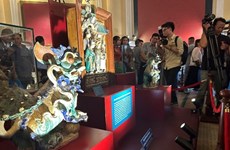Hue carvings proposed as UNESCO Memory of the World
The Hue royal architectures engraved with poetry will be proposed as a
valuable archive in UNESCO’s Memory of the World list, as heard at a
recent workshop held in Hue city in the central province of Thua
Thien- Hue.
The Hue royal architectures engraved with poetry will be proposed as a
valuable archive in UNESCO’s Memory of the World list, as heard at a
recent workshop held in Hue city in the central province of Thua
Thien- Hue.
The poetries carved on imperial buildings in Hue comprise selective works by emperors and mandarins from the Nguyen dynasty dating from 1802-1945. They are carved, encrusted and enamelled on royal architectures with various materials such as wood, vitreous enamel and ceramics.
Although Han Chinese characters were used for the poems, they are different from carved calligraphy found on ancient buildings in China .
Carved poems can be seen at Thai Hoa Palace, The To Temple, Hung To Temple inside the former imperial palace, in the mausoleums for Kings Minh Mang, Thieu Tri, Dong Khanh and Duc Duc, and in pagodas and residences of royal families and mandarins.
The buildings encompass all criteria required to receive the honour of a documentary heritage, including practicality, uniqueness, role internationally, integrity and endangered status, the Van Hoa (Culture) online newspaper quoted Professor Dr. Luu Tran Tieu as saying.
At the event, he highlighted that it is necessary to clarify the uniqueness and international influence of the archives when presenting them for consideration of recognition by UNESCO.
Meanwhile, Vu Thi Minh Huong, Chairwoman of the National Committee for Memory of the World, said the Hue Monuments Conservation Centre should collaborate with relevant agencies to protect and promote the archives’ values by organising workshops and media campaigns.
Leading conservationists at the workshop agreed that preserving the buildings is a prerequisite for the protection of the poetry system. They said practical measures should be taken to protect the carvings from natural disasters.
Director of the conservation centre Phan Thanh Hai affirmed that together with profiling crucial documents about the carvings for UNESCO’s recognition, the centre will digitalise poetries carved on the heritage buildings to promote their values.
Currently, Vietnam has four documentary heritages recognised as Memories of the World: the Nguyen dynasty wood blocks, the stone steles preserved at the Temple of Literature, Buddhist-Sutra woodblocks stored at Vinh Nghiem Pagoda and Imperial records from the Nguyen Dynasty.
UNESCO launched the Memory of the World Programme in 1994 to guard against collective amnesia and to call upon the preservation of valuable archive holdings and library collections all over the world.-VNA
The poetries carved on imperial buildings in Hue comprise selective works by emperors and mandarins from the Nguyen dynasty dating from 1802-1945. They are carved, encrusted and enamelled on royal architectures with various materials such as wood, vitreous enamel and ceramics.
Although Han Chinese characters were used for the poems, they are different from carved calligraphy found on ancient buildings in China .
Carved poems can be seen at Thai Hoa Palace, The To Temple, Hung To Temple inside the former imperial palace, in the mausoleums for Kings Minh Mang, Thieu Tri, Dong Khanh and Duc Duc, and in pagodas and residences of royal families and mandarins.
The buildings encompass all criteria required to receive the honour of a documentary heritage, including practicality, uniqueness, role internationally, integrity and endangered status, the Van Hoa (Culture) online newspaper quoted Professor Dr. Luu Tran Tieu as saying.
At the event, he highlighted that it is necessary to clarify the uniqueness and international influence of the archives when presenting them for consideration of recognition by UNESCO.
Meanwhile, Vu Thi Minh Huong, Chairwoman of the National Committee for Memory of the World, said the Hue Monuments Conservation Centre should collaborate with relevant agencies to protect and promote the archives’ values by organising workshops and media campaigns.
Leading conservationists at the workshop agreed that preserving the buildings is a prerequisite for the protection of the poetry system. They said practical measures should be taken to protect the carvings from natural disasters.
Director of the conservation centre Phan Thanh Hai affirmed that together with profiling crucial documents about the carvings for UNESCO’s recognition, the centre will digitalise poetries carved on the heritage buildings to promote their values.
Currently, Vietnam has four documentary heritages recognised as Memories of the World: the Nguyen dynasty wood blocks, the stone steles preserved at the Temple of Literature, Buddhist-Sutra woodblocks stored at Vinh Nghiem Pagoda and Imperial records from the Nguyen Dynasty.
UNESCO launched the Memory of the World Programme in 1994 to guard against collective amnesia and to call upon the preservation of valuable archive holdings and library collections all over the world.-VNA













